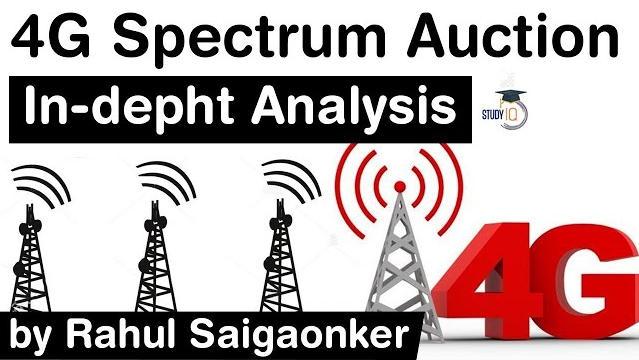Table of Contents
The News
- Recently, India’s first auction of telecommunications spectrum in five years took place.
- The government generated a revenue of Rs77,815 crore from the exercise.
What happened?
- Mukesh Ambani-led Reliance Jio accounted for close to 60% of the spectrum bought, followed by Bharti Airtel and Vodafone Idea.
- How much was offered?
- Government offered was over 2,308 megahertz (MHz) of spectrum valued for the auction by the government at Rs3.92 lakh crore.
- Department of Telecommunications (DoT) auctioned 4G spectrum in the 700, 800, 900, 1,800, 2,100, 2,300, and 2,500 MHz bands.
- Bids were successfully received for 37% or 855.6 MHz.
What was new this time?
- Deferred Payment plan introduced by GOI
- Bidders for the sub-1 GHz bands of 700, 800 and 900 MHz can opt to pay 25 per cent of the bid amount now, and the rest later.
- Bidders in the above-1 GHz bands of 1,800, 2,100, 2,300, and 2,500 MHz frequency bands, will have to pay 50 per cent upfront, and can then opt to pay the rest in equated annual instalments.
What is this Spectrum?
Who controls this Spectrum?
Spectrum is a sovereign asset.
- The use of the airwaves in each country is overseen by the government or the designated national regulatory authority, which manages it and issues the needed licenses.
- Frequency matters
- In general, low-frequency transmissions can travel greater distances before losing their integrity but carry less data.
- Higher-frequency transmissions carry more data, but are poorer at penetrating obstacles and hence lesser reach.
- It is a big job of National regulatory authorities to allocate and license appropriate resources to the services and sectors that can make the most of it.
- Ex: Your WiFi at home can be 2.5GHz or 5 GHz also..!!
- With 5GHz you’ll get great speed and low interference but will be able to connect to less devices. With 2.5 GHz you’ll get lower speeds but greater reach.
1G to 5G – History
1G to 5G – History
- 5G needs a significant amount of new harmonised mobile spectrum, so defragmenting and clearing prime bands should be prioritized by GOI.
- Telecom authorities should aim to make available 80-100 MHz of contiguous spectrum per operator in prime 5G mid-bands (3.5 GHz).
- Around 1 GHz per operator in high-bands. (8 GHz)
- Low-bands (0.7-0.9 MHz) are also needed to support widespread coverage across urban, suburban and rural areas and help support Internet of Things (IoT) services.
Lets talk about Current auction
- Was it 5G auction?
- .!!
- Who bought what?
- Jio : Reliance Jio was the biggest spender in the auction. It shelled out 57,122 crore, just over 60% of which was to acquire spectrum in the 800 MHz band. It spent the remaining on 1,800 MHz and 2,300 MHz bands.
- Airtel : Bharti Airtel dished out 18,699 crore. Spent half of its money on the 800 MHz and 900 MHz bands. It also spent on the 2,100 MHz and 2,300 MHz bands.
- Vi: 1,993-crore spend on the 900 MHz band. It spent the remaining on the 1,800 MHz band.
- Note: The spectrum will be assigned to bidders for a period of 20 years.
What does this mean?
- Reliance Jio spent “higher-than-expected” in an attempt to improve network experience because already Bharti Airtel has higher share of smartphone subscribers due to its superior network.
- Vodafone Idea’s low-key presence in the auction is linked to its balance-sheet constraints.
- It is also likely that the players are preserving their resources for the upcoming 5G era. Hence only 37% of auctioned spectrum was bought..!!
Comparison – 2016 v 2020
- In 2016, about 40% of the 2,355 MHz of spectrum (at a reserve price of 5.6 lakh crore) was sold, giving the government 65,789 crore in revenue.
- Last time many players were involved in auction..!!
- Bharti Airtel, Vodafone, Idea Cellular, Reliance Communications, Tata Teleservices, Aircel and Reliance Jio had applied to participate in the auction.
- This time the auction yielded, more revenue despite low expectations due to economic downturn caused by the COVID-19 pandemic.

























 WhatsApp
WhatsApp